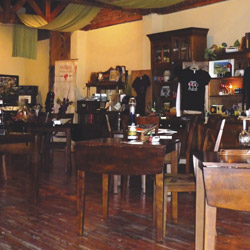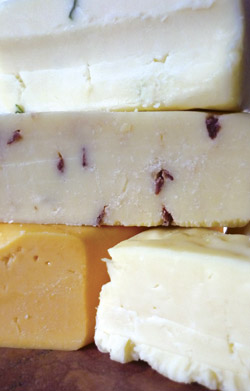It was 230 years ago at La Ville de Maillet when vintners from surrounding vineyards brought their grape harvests to the village’s wine press and stored their wares in a shared underground wine vault. These villagers celebrated what the French call terroir, the concept that wine has a sense of place and embodies the unique tastes and flavors of the land on which it is grown. La Ville de Maillet is the home we now call Peoria.
By 1900, Illinois was the fourth-largest wine producer in the United States, a tradition that went by the wayside when Prohibition forced our vineyards to be uprooted for corn and soybeans. Today, Illinois wine country has had a rebirth with the development of hybridized grapes that withstand our winters’ hard freezes.
“People are always trying to compare Illinois wines to California wines, and that’s really not a fair comparison—the wines are just different. Climate-wise the Midwest has more of an affinity with France and the grapes grown there,” said David Conner, owner and winemaker at Kickapoo Creek Winery in Edwards.
In French, the word for winemaker is vigneron, which literally translates as “wine-grower” and is a much more apt description of winemakers in central Illinois.
“I like to grow things and growing grapes seemed like a natural fit. I looked at our location, with its rolling and open ground, and it made me think of a vineyard,” Conner adds.
The first of the vineyard’s 20 varieties of grapes were planted in 2003. The soil at Conner’s 13-acre vineyard is referred to as “timber soil,” meaning that it is on higher, rolling ground not suitable for major crops, but grapes are thriving and producing up to a gallon of wine for each plant.
“For those who try our wines, they can taste the difference of buying local. The grapes are picked fresh and the wine is made on the premises. The product is much better,” Conner said.
“People want to see where their food is being raised. Every area in the state has a different climate and a different taste to their wine.” 
This difference in climate and soil makes the wines produced at Willett’s Winery and Cellar in Manito a true example of terroir. On the drive to the winery, you will notice the irrigation systems that keep farmland viable in Mason County’s dry, sandy ground.
“My husband, Dan, and I grow corn on our farm and had been looking for a way to utilize a 10-acre spot that was landlocked and couldn’t benefit from the traditional irrigation systems we use on the rest of our land,” Cris Willett said. As the Willetts searched for ideas, they hit upon grapes. More than 2,700 vines were planted in 2001, with each vine having its own drip irrigation system.
Willett’s Winery and Cellar opened in 2005 in a restored building built in 1893. An architect, Dan Willett put his expertise to work in exposing the wood beams of what was originally a harness shop. His efforts have created a quaint, European atmosphere in the heart of a small town.
“I think one of the things that makes our winery different from others is that it is not at the vineyard. We made a decision to have it downtown and restore a building that was an important part of the community,” Willett said.
Today, the winery has become a hub of entertainment. The Willetts, who come from a family of home winemakers, have learned about wine as their business has grown.
“If anyone had asked us 10 years ago if we would have a winery, we would have said ‘no.’ This has just evolved. Customers like learning about our wines and the romance of how we got to where we are,” Willett adds.
The romance of how local foods get their start is not lost on the Ropp family. For more than 10 years, Ray and Carol Ropp, and their son, Ken, dreamed of finding a way to bring more people back to the land. They know firsthand how vital agriculture and their locally made cheese is the perfect accompaniment to local wines.
“It is important to see a working farm. Before there was always a grandmother or a grandfather who farmed, but now many people are three and four generations removed from farming,” Ray Ropp said. His farm, which his parents started in 1928, has always been a dairy farm.
The Ropps produce up to 17 pounds of cheese for every 100 gallons of milk. This process starts in the morning with milking, then pasteurization and ending with cheese production.
“Only 10 to 12 cents of what consumers pay for food makes it back to farmers and we were looking for an opportunity to increase our return,” Ray adds.
When his son, Ken, visited the World Dairy Expo a few years ago, he knew he had found the right opportunity for the family farm—a portable cheese-making unit that is installed on the premises.
“We’re the only dairy farm in Illinois that raises and cares for our own cows and are able to make and sell the cheese on site,” Ken Ropp explains. Today, Ropp Jersey Cheese offers more than 45 varieties of cheese.
Since the Ropps also grow their own grain for feed, the flavors of their cheese are just as unique as any local wine. With increasing demand from more than 70 retail locations, including their own retail store on the farm, the Ropps have doubled their herd. 
“Jersey cows are a smaller breed and are very efficient at turning feed into milk—a milk that is very high in protein and butterfat content making for a better cheese,” Ray said.
Since April 2007, more than 8,000 students have visited the Ropp farm to learn about the cows and see cheese being made—something Ray’s wife, Carol, a retired school teacher, has really enjoyed.
“We’re busier than we thought we’d be, faster than we thought we’d be. Many people have sought us out because we’re the only all-natural cheese in a 150-mile radius. The variety of cheese we make is amazing and while we’re learning along the way, we’re also sharing what we know through the tours,” Carol Ropp said.
The Ropps noted how their customers are becoming more conscious about food choices.
“Years ago we had the corner butcher shop for fresh eggs and milk, then smaller corner grocery stores, and then the big-box stores. Now though, everything is circling back and customers want to know what they are eating and where their food is coming from,” Ken Ropp said. a&s


